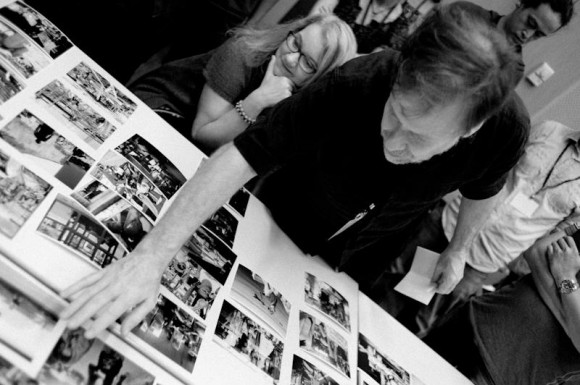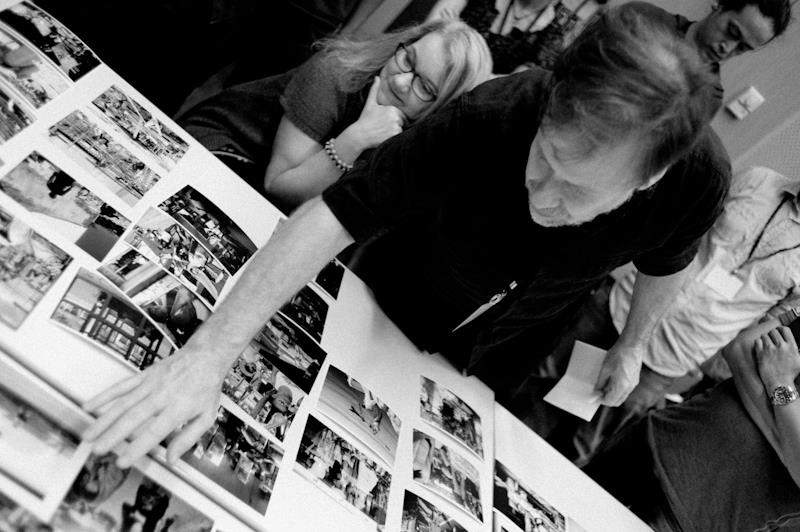Final Part 10 transcription of the Q&A session during the public talk given by photographers Alex Webb and Rebecca Norris Webb, and David Chickey of Radius Books, at The National Museum Of Singapore on 9th March, 2012.

Bookmaking and Layout
Question: This question is on bookmaking and layout design. You know when I received Violet Isle, I was like, “Wow! You know, this is the book.” But then when I flip through and when I start seeing images running across the spine, it is not double-spread. Not full double-spread, I feel it is very disturbing. Sorry, I felt “Oh darn, why did they do this?” I could not sleep because of that. (Laugh) So perhaps, you could explain the reason behind that, just having “that bit” across the spine, not full, that breaks the picture in the middle? Thanks.
David: When we start doing a book, we deal with the spine and what happens across the gutter of the book. It’s a conversation that we have with almost every book we published, about how we’re going to deal with it. What problems are produced and what problems are solved.
So in this book, specifically when we started working on Violet Isle, we started talking about the design of the book. We have lots of conversations about its images and how they might work across the gutter and how they be compromised. In that book specifically, the design we chose was one where images slip back and forth. They are not all centered in the middle of the page. They slip back and forth based on what is happening, what falls in the gutter is probably the most advantageous way to have that image.
But it was a decision born out of the scale of the book and the complexity of the images where if you produce the images smaller than the page, you’ll have so much going on, to run them that small on a single one page, you don’t feel that you will fall into them. This idea of wanting to sort of fall into the images and if you could fall into the book as a whole, you are falling into the gutter, you will fall into the image. So it’s a choice that’s made. A lot of what happens in books and book design is a compromise of the best you can have of everything. So we gain some things by making that decision but probably lost some things as well.
Alex: I mean, we’ve done books that are both ways. Violet Isle had double spreads running through it. I think, Rebecca and I, all along, wanted that. Even though we know the problems of losing things in the gutter. And from our perspective, I think part of what we wanted, we felt the double spreads was that we felt it was a better way to express the notion of two individual visions than having pictures opposite one another.
Most of the time, it was like there’s a picture of Rebecca’s, there’s a picture of Alex’s, there’s a picture of Rebecca’s, there’s a picture of Alex’s. So it’s setting up that dynamic of this two different visions, basically talking to one another, we felt was so much better solution.
Now my Haiti book also has double spreads in it. My Haiti book, I wanted it to seem like a report. So I wanted the book to have echoes of a magazine, you know, Life magazine always have big double spreads. So there are double spreads that run through it too. The same thing actually happens less dramatically as the picture moves back and forth a little bit but not cut in too problematic places. But there’s one picture, cover picture, of the Haiti book that is really screwed by the double spread. But I felt it was ok because it’s on the cover.
My border book also has double spreads and again, because I felt it to have the report, a report of the borders, that journalistic resonance. On the other hand, The Suffering of Light, you know, on some level, I wanted that book among other things. I know my galleries wanted this to serve almost as a kind of catalog of my work. And I wanted people to see the totality of the images in that book. But it is also a bunch of former books. We were able to, you know, wanting to do a larger format book so the pictures are large enough so that you could get into them, the way David was talking about, getting into the double spreads.
There’s no easy solution and, you know, you do a bigger book that’s harder for people to hold and not as intimate. You do a smaller intimate book, you don’t see the pictures as well. There are all kinds of complicated compromises.
David: We have a lot of conversations about the design, about how the book could be, what was the exact of the book and how the vertical versus the horizontal. How the vertical images would be played out. It’s a part of the conversation, certainly of books I designed and published and certainly of all the books we’ve done together. And again, it’s one conversation we had at the start of the process.
Text: Sebastian Song
Read All Transcriptions:
Q&A with Alex Webb, Rebecca Norris Webb & David Chickey
Share


Comments 12
Pingback: How It All Began: A Book Mockup | Paradise
Pingback: Making the Photo Book 1: Choices and Decisions | Invisible Ph t grapher Asia (IPA)
Q&A with Webbs & Chickey Part 10: Bookmaking and Layout http://t.co/GhJW80qo
Q&A with Webb and Chickey: Bookmaking and Layout http://t.co/Fb05wsDm
RT @budinddharmawan: Q&A w/ Alex Webb, Rebecca Webb, David Chickey: bookmaking & layout http://t.co/Z8w3ngHe – @InvisPhotogAsia
@InvisPhotogAsia – Q&A with Webbs & Chickey Part 10: Bookmaking and Layout http://t.co/RybClqgU #Asia #photography
Q&A w/ Alex Webb, Rebecca Webb, David Chickey: bookmaking & layout http://t.co/K6ySxsmi – @InvisPhotogAsia | @_wid @ditoyuwono
Q&A with Webbs & Chickey Part 10: Bookmaking and Layout http://t.co/qnt3nKyP
Q&A with Webbs & Chickey Part 10: Bookmaking and Layout http://t.co/k8f3kzSQ #photojournalism
In this final transcript, David Chickey & Alex Webb talk about Photo Bookmaking and Layout…. http://t.co/WJ43WLcr
RT @InvisPhotogAsia: In this final transcript, David Chickey & Alex Webb talk about Photo Bookmaking and Layout…. http://t.co/TLjpGevU
RT @InvisPhotogAsia: In this final transcript, David Chickey & Alex Webb talk about Photo Bookmaking and Layout…. http://t.co/UgraMDAL